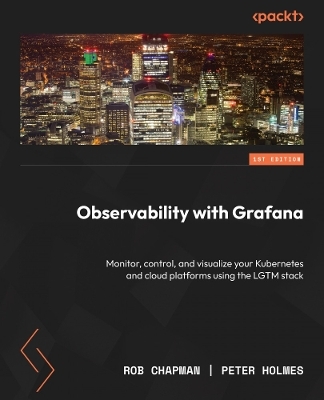
Observability with Grafana
Packt Publishing Limited (Verlag)
978-1-80324-800-4 (ISBN)
Key Features
Use personas to better understand the needs and challenges of observability tools users
Get hands-on practice with Grafana and the LGTM stack through real-world examples
Implement and integrate LGTM with AWS, Azure, GCP, Kubernetes and tools such as OpenTelemetry, Ansible, Terraform, and Helm
Purchase of the print or Kindle book includes a free PDF eBook
Book DescriptionTo overcome application monitoring and observability challenges, Grafana Labs offers a modern, highly scalable, cost-effective Loki, Grafana, Tempo, and Mimir (LGTM) stack along with Prometheus for the collection, visualization, and storage of telemetry data.
Beginning with an overview of observability concepts, this book teaches you how to instrument code and monitor systems in practice using standard protocols and Grafana libraries. As you progress, you’ll create a free Grafana cloud instance and deploy a demo application to a Kubernetes cluster to delve into the implementation of the LGTM stack. You’ll learn how to connect Grafana Cloud to AWS, GCP, and Azure to collect infrastructure data, build interactive dashboards, make use of service level indicators and objectives to produce great alerts, and leverage the AI & ML capabilities to keep your systems healthy. You’ll also explore real user monitoring with Faro and performance monitoring with Pyroscope and k6. Advanced concepts like architecting a Grafana installation, using automation and infrastructure as code tools for DevOps processes, troubleshooting strategies, and best practices to avoid common pitfalls will also be covered.
After reading this book, you’ll be able to use the Grafana stack to deliver amazing operational results for the systems your organization uses.What you will learn
Understand fundamentals of observability, logs, metrics, and distributed traces
Find out how to instrument an application using Grafana and OpenTelemetry
Collect data and monitor cloud, Linux, and Kubernetes platforms
Build queries and visualizations using LogQL, PromQL, and TraceQL
Manage incidents and alerts using AI-powered incident management
Deploy and monitor CI/CD pipelines to automatically validate the desired results
Take control of observability costs with powerful in-built features
Architect and manage an observability platform using Grafana
Who this book is forIf you’re an application developer, a DevOps engineer, a SRE, platform engineer, or a cloud engineer concerned with Day 2+ systems operations, then this book is for you. Product owners and technical leaders wanting to gain visibility of their products in a standardized, easy to implement way will also benefit from this book. A basic understanding of computer systems, cloud computing, cloud platforms, DevOps processes, Docker or Podman, Kubernetes, cloud native, and similar concepts will be useful.
Rob Chapman is a creative IT engineer and founder at The Melt Cafe, with two decades of experience in the full application life cycle. Working over the years for companies such as the Environment Agency, BT Global Services, Microsoft, and Grafana, Rob has built a wealth of experience on large complex systems. More than anything, Rob loves saving energy, time, and money and has a track record for bringing production-related concerns forward so that they are addressed earlier in the development cycle, when they are cheaper and easier to solve. In his spare time, Rob is a Scout leader, and he enjoys hiking, climbing, and, most of all, spending time with his family and six children. Peter Holmes is a senior engineer with a deep interest in digital systems and how to use them to solve problems. With over 16 years of experience, he has worked in various roles in operations. Working at organizations such as Boots UK, Fujitsu Services, Anaplan, Thomson Reuters, and the NHS, he has experience in complex transformational projects, site reliability engineering, platform engineering, and leadership. Peter has a history of taking time to understand the customer and ensuring Day-2+ operations are as smooth and cost-effective as possible.
Table of Contents
Introducing Observability and the Grafana Stack
Instrumenting Applications and Infrastructure
Setting Up a Learning Environment with Demo Applications
Looking at Logs with Grafana Loki
Monitoring with Metrics using Grafana Mimir and Prometheus
Tracing Technicalities with Grafana Tempo
Interrogating Infrastructure with Kubernetes, AWS, GCP, and Azure
Displaying Data with Dashboards
Managing Incidents using Alerts
Automation with Infrastructure as Code
Architecting an Observability Platform
Real User Monitoring with Grafana
Application Performance with Grafana Pyroscope and k6
Supporting DevOps Processes with Observability
Troubleshooting, Implementing Best Practices, and More with Grafana
| Erscheinungsdatum | 14.12.2023 |
|---|---|
| Verlagsort | Birmingham |
| Sprache | englisch |
| Maße | 191 x 235 mm |
| Themenwelt | Mathematik / Informatik ► Informatik ► Netzwerke |
| Informatik ► Software Entwicklung ► Qualität / Testen | |
| ISBN-10 | 1-80324-800-9 / 1803248009 |
| ISBN-13 | 978-1-80324-800-4 / 9781803248004 |
| Zustand | Neuware |
| Informationen gemäß Produktsicherheitsverordnung (GPSR) | |
| Haben Sie eine Frage zum Produkt? |
aus dem Bereich


